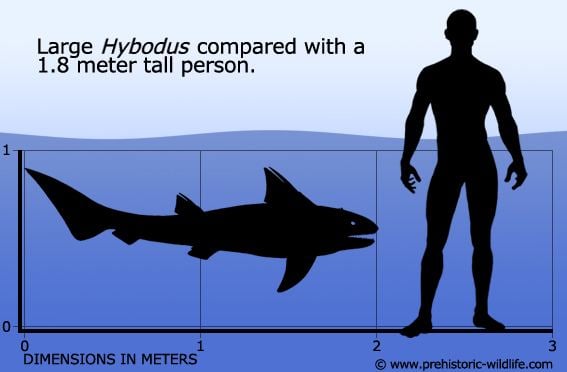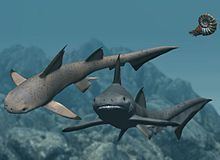Superfamily †Hybodontoidea Phylum Chordata | Superorder Selachimorpha Rank Genus Subclass Elasmobranchii | |
 | ||
Similar Hybodontiformes, Stethacanthus, Cladoselache, Cretoxyrhina mantelli, Lissodus | ||
Prehistoric shark week hybodus
Hybodus ("humped tooth") is an extinct genus of Chondrichthyans. First appearing towards the end of the Permian period, and disappearing during the Late Cretaceous, during the Triassic, Jurassic, and Cretaceous periods the hybodonts were especially successful and could be found in shallow seas across the world. For reasons that are not fully understood, the hybodonts became extinct near the end of the Late Cretaceous period.
Contents
- Prehistoric shark week hybodus
- Hybodus vs stethacanthus
- Description
- Species
- In popular culture
- References

Hybodus vs stethacanthus
Description
Hybodus species grew to about 2 metres (6.6 ft) in length, and are believed to have been opportunist predators. It was not very big, but had the classic streamlined shark shape, complete with two dorsal fins that would have helped it steer with precision. The mouth was not large, and rather than ruthlessly hunt large prey, Hybodus, was capable of eating a wide range of foods. They had several distinct features that made them stand apart from other primitive sharks. Firstly, they had two different types of teeth, suggesting a wide diet. The sharper teeth would have been used to catch slippery prey, while the flatter teeth probably helped them crush shelled creatures. Secondly, they had a bony blade on their dorsal fin that probably served a defensive function. The males also possessed claspers, specialized organs that directly insert sperm into the female, and which are still present in modern sharks.
The youngest Hybodus fossils come from the Dinosaur Park Formation. They date from 68.6 to 66 million years ago.
The first fossilized teeth from Hybodus were found in England around 1845. Since then teeth (and dorsal spines) have been recovered from around the world.
Species
Several Hybodus species, including H. butleri, H. rajkovichi, and H. montanensis, were later reassigned to Meristodonoides.
In popular culture
Hybodus was featured in the third episode of the 1999 documentary series Walking with Dinosaurs, being attracted to the blood of an Ophthalmosaurus in labor. It was unidentified in the UK version. Hybodus made its return in the 2003 spin-off Sea Monsters, where it was shown feeding on a giant struggling Leedsichthys with Metriorhynchus.
In 2004, the children's book Jurassic Shark by Deborah Diffily (illustrated by Karen Carr) highlights a pregnant female Hybodus shark battling a Liopleurodon and hunting ichthyosaurs.
